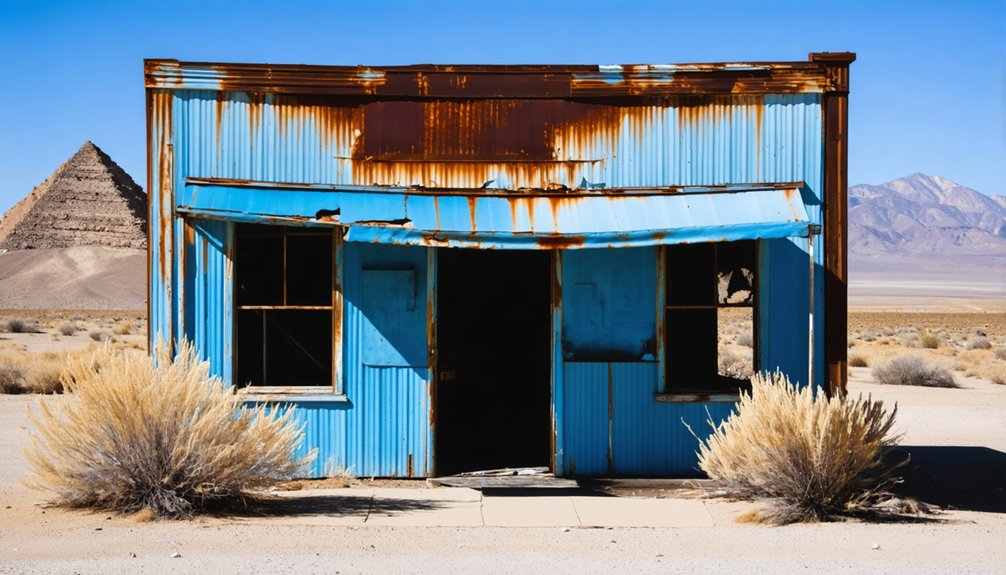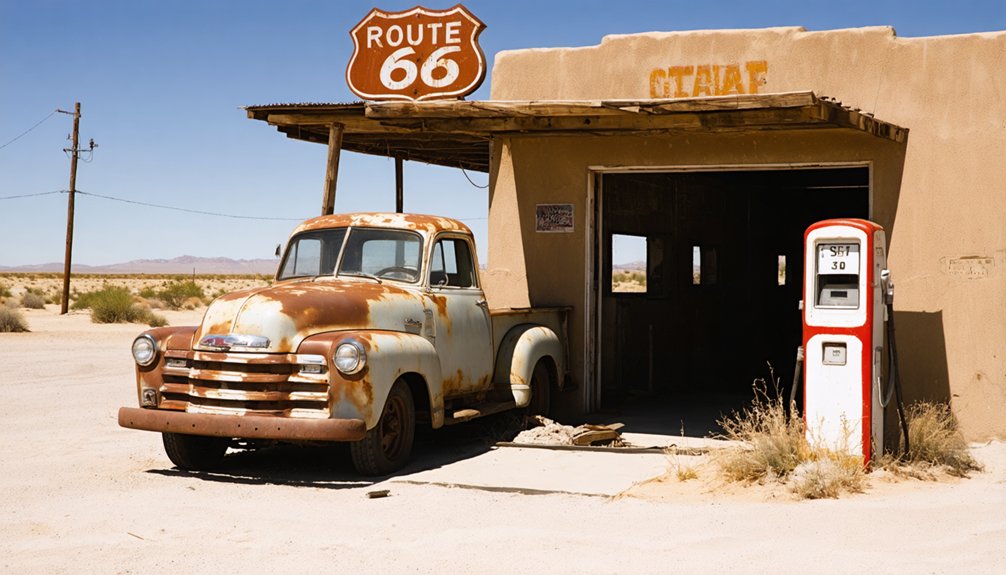You’ll find that Barstow’s mining heritage began in the 1880s when silver was discovered in nearby Calico, transforming this railroad junction into a bustling boomtown of 3,500 residents. The town thrived with over 500 mines producing $20 million in silver ore until prices crashed in the mid-1890s. While modern Barstow continues as a living city, Calico Ghost Town‘s preserved 480 acres offer an authentic glimpse into California’s silver mining era, with five original structures still standing.
Key Takeaways
- Barstow began as a mining settlement in the 1880s, named after railroad president William Barstow Strong during the California silver rush.
- The nearby Calico Ghost Town, once a thriving silver mining area, produced over $20 million in silver ore during peak operations.
- Walter Knott restored Calico Ghost Town in 1951, preserving five authentic structures from the 1880s mining era.
- Calico Ghost Town now spans 480 acres with guided mine tours, shops, restaurants, and historic buildings for tourists.
- The town’s decline occurred in the mid-1890s when plummeting silver prices forced mine closures and population exodus.
The Birth of a Silver Mining Legend
While many California towns emerged from the Gold Rush era, Barstow’s origin story revolves around silver, beginning as a humble settlement known as Fishpond and Waterman Junction in the early 1880s.
You’ll find its mining heritage deeply rooted in Robert W. Waterman’s ambitious claims, which marked some of California’s largest silver strikes.
When prospectors discovered silver at nearby Calico in 1881-1882, the silver rush transformed this quiet desert outpost into a bustling frontier town.
By 1886, the settlement had earned a new name – Barstow – honoring William Barstow Strong, the Santa Fe Railway president who’d help cement the town’s future.
The railway’s arrival proved essential, connecting the silver mines to distant markets and establishing Barstow as a significant hub in California’s mining landscape. The Southern Pacific Railroad reached the area in 1883, setting the stage for major transportation developments. The area experienced typical boom and bust cycles as silver deposits were gradually depleted.
Life in the Bustling Boomtown
As the silver rush drew thousands to Barstow and nearby Calico in the 1880s, daily life took on the unmistakable rhythm of a frontier boomtown.
You’d find yourself living in hastily built wooden cabins or tents, sharing the challenges of desert life with a remarkably diverse community of Irish, Chinese, and Mexican miners.
Community resilience showed in how residents banded together, establishing schools, churches, and volunteer fire brigades despite the harsh conditions.
Frontier neighbors forged enduring bonds, building vital community institutions amid the unforgiving desert landscape of 1880s Barstow.
You’d spend your evenings at the bustling saloons or music halls, where cultural diversity flourished through shared entertainment.
The 20-mule teams transported ore between mining sites, creating a constant stream of activity throughout the town.
While you’d face the daily struggles of water scarcity, extreme temperatures, and limited medical care, the strong social bonds formed through community gatherings, sports events, and holiday celebrations helped sustain the town’s spirit through boom and bust cycles.
The town’s growth was further cemented when the Atchison, Topeka & Santa Fe railroad arrived, transforming Barstow into a vital transportation hub.
Mining Operations and Economic Growth
Beyond the social fabric of Barstow’s frontier life lay the economic engine that built the town: mining. You’d find silver and gold strikes throughout the Owens Valley triggering a remarkable economic transformation in the 1860s and 1870s.
The establishment of Barstow as a division point for railroads proved crucial for the mining industry’s sustainability. The Waterman Mine emerged as one of California’s largest silver producers, while the Calico Hills yielded an impressive $9 million in borax by 1902. Due to frequent naming confusion with other mining towns, local authorities created disambiguation records to properly document the area’s industrial growth.
Mining techniques evolved as operations expanded, with both surface and underground methods adapting to the region’s geology.
The arrival of the Southern Pacific Railroad in 1883, followed by Santa Fe in 1884, revolutionized the industry’s capabilities. These rail lines transformed Barstow into an essential transportation hub, enabling efficient movement of ore and supplies while supporting a workforce of 200 men across three major borax mines.
From Prosperity to Abandonment
Once silver was discovered in the Calico region on April 6, 1881, the area transformed into a bustling mining powerhouse centered around the Silver King Mine.
You’d have seen over 500 mines operating at peak production, generating an impressive $20 million in silver ore over just 12 years. The district dominated San Bernardino County’s silver output, accounting for 80% by 1884.
The town grew rapidly to include a population of 3,500 residents with established schools, churches, and local laws. But you couldn’t escape the economic collapse that hit in the mid-1890s when silver prices plummeted. The once-thriving mining hub quickly lost its workforce as both the silver and borax industries failed. In 1951, Walter Knott stepped in to restore the abandoned town to its former glory.
Walter Knott’s Vision for Preservation
When Walter Knott purchased Calico Ghost Town in 1951, he set out on an ambitious $700,000 restoration project that would preserve an essential piece of California’s mining heritage.
His preservation techniques combined meticulous archival research with oral histories from original residents, ensuring historical accuracy in every detail. You’ll find that while only five original buildings remained, Knott’s team reconstructed the rest using old photographs as references. The town features a distinctive glass bottle house reminiscent of his work at Knott’s Berry Farm.
His vision went beyond mere reconstruction – he wanted to create an immersive experience that would educate visitors about California’s silver mining era. He worked closely with art director Paul Von Cleveland to authentically recreate the historical structures.
Knott’s dedication paid off when Calico earned its designation as California Historical Landmark No. 782. In 1966, he gifted the restored town to San Bernardino County, ensuring its legacy would continue as a regional park for future generations.
Modern-Day Tourist Experience
Today’s visitors to Calico Ghost Town discover a vibrant blend of historical preservation and modern entertainment spanning 480 acres.
You’ll find compelling tourist attractions like the guided Maggie Mine tours, where mannequins recreate miners’ lives, and the Mystery Shack, where water seemingly defies gravity by running uphill.
Try your luck at gold panning or hop aboard the Calico Odessa Railroad for a scenic journey through the park.
Experience Old West adventure as you sift for precious metals or take a relaxing train ride through scenic Calico terrain.
Visitor amenities include three restaurants, fourteen specialty shops, and diverse lodging options from RV camping to cozy cabins.
You’re welcome daily from 9 AM to 5 PM, with entry fees of $8 for adults and $5 for youth.
Throughout the year, you can experience special events like Civil War re-enactments, the Calico Days Festival, and the spooky Halloween Ghost Haunt.
Historical Landmarks and Architecture

You’ll find several authentic structures from Barstow’s mining heyday still standing today, including the iconic Sheriff’s Office and original sections of the Maggie Mine complex.
The buildings showcase typical 1880s Western mining town construction, featuring wooden false-front architecture and locally-sourced materials that helped the settlements expand quickly during the silver boom.
Walter Knott’s meticulous 1950s restoration work preserved and rebuilt many of Calico’s original buildings to match their 1880s appearance, ensuring future generations could experience authentic mining-era architecture.
Original Buildings Still Standing
The original buildings of Calico stand as remarkable monuments to the town’s silver mining era, with five authentic structures preserved among the carefully restored 1880s townscape.
These remaining structures showcase the architectural significance of this historic mining town, each telling a unique story of frontier life.
- You’ll find Lucy Bell Lane’s home, now a museum featuring period furniture and a rare original porcelain bathroom.
- You can explore the Bottle House, an innovative structure built entirely from glass bottles.
- You’ll discover the Old Sheriff’s Office, a symbol of law and order during the mining boom.
- You can visit Maggie’s Mine, complete with interpretative displays about miners’ lives and the silver extraction process.
The preservation efforts, guided by old photographs and local accounts, maintain these buildings’ authentic character while educating visitors about Calico’s rich history.
Mining Era Construction Methods
During Calico’s peak mining years, construction methods reflected both ingenuity and practicality in harsh desert conditions.
You’ll find extensive use of timber support systems throughout the mines, where wooden sets and cribbing prevented cave-ins as miners dug deeper into the mountain. The mining operations required substantial infrastructure, including stamp mills for crushing ore and sophisticated water management systems for hydraulic mining activities.
Near the mines, you’ll spot remnants of support buildings that served vital functions.
These structures utilized locally available materials – primarily wood, though some stone and adobe were incorporated where durability was essential. Assay offices, equipment sheds, and processing facilities were built with straightforward wooden construction methods, prioritizing function over form in the demanding desert environment.
Restored Historical Structures
While original mining-era structures showcased practical frontier construction, today’s Calico Ghost Town stands as a masterfully restored historical site thanks to Walter Knott’s 1950s preservation efforts.
You’ll find meticulous restoration techniques applied throughout the town, maintaining historical accuracy while making the site accessible for modern visitors.
- Five original buildings remain untouched, serving as authentic anchors among the carefully reconstructed structures
- The Sheriff’s Office, courthouse, and general stores feature period-appropriate wooden frames and false-front facades
- The Maggie Mine offers safe exploration of preserved mining operations
- The iconic Bottle House demonstrates unique frontier resourcefulness with its glass bottle walls
Each restored building incorporates wooden plank sidewalks, shingled roofs, and wrought iron hardware that capture the essence of Western boomtown architecture.
The Legacy of California’s Silver Rush

Although California’s legacy primarily stems from the Gold Rush of 1848-1855, silver’s impact on the region proved equally transformative for the American West.
While gold built California’s reputation, silver mining equally shaped the American West’s transformation and development.
You’ll find that silver extraction in neighboring Nevada, particularly with the Comstock Lode discovery in 1859, drew prospectors away from California’s goldfields and revolutionized mining technology. The silver deposits, often found as silver chloride near the surface, were easier to extract than gold, leading to rapid development of the region.
As you explore ghost towns like Barstow, you’ll notice how the silver boom helped finance essential infrastructure, including railroads and telegraph systems.
The rush brought diverse populations westward, though this came at a devastating cost to Native American communities. Wells Fargo & Co. and other businesses flourished, establishing economic foundations that would shape California and Nevada’s future.
Frequently Asked Questions
What Dangerous Wildlife Might Visitors Encounter in the Calico Area?
You’ll need to watch for desert predators like coyotes, plus dangerous rattlesnake encounters. Don’t forget black widow spiders and bark scorpions hiding in dark spaces and crevices.
Are There Any Reports of Paranormal Activity in Calico Ghost Town?
Persistent paranormal presences await you in Calico. You’ll find ghost sightings at Hank’s Hotel, Maggie’s Mine, and Lucy Lane’s home. The haunted history includes doors slamming shut and unexplained cold spots.
How Extreme Do Temperatures Get During Summer and Winter Months?
You’ll face extreme temperature variations, from scorching 109.6°F summer days to chilly 25°F winter nights. Summer lows cool to 74.8°F, while winter days stay mild around 64.2°F, giving you seasonal relief.
Can Visitors Stay Overnight in Any of Calico’s Historic Buildings?
You can’t stay overnight in Calico’s historic buildings due to historic preservation rules. Instead, you’ll find modern overnight accommodations in nearby cabins, bunkhouses, or campgrounds designed for visitor use.
What Native American Tribes Originally Inhabited the Calico Mountains Region?
While you’ll hear many claims about the area’s history, historical records show the Mojave tribe primarily inhabited this region, with Paiute and Kawaiisu peoples also having significant ties to these mountains.
References
- https://main.sbcounty.gov/2025/05/29/san-bernardino-county-history-calico-ghost-town/
- https://www.desertsun.com/story/desert-magazine/2019/06/20/route-66-hidden-gems-worth-exploring-ghost-towns-50-s-diners/1506019001/
- https://en.wikipedia.org/wiki/Calico
- https://www.youtube.com/watch?v=ILv_uPHtpyM
- https://www.visitcalifornia.com/road-trips/ghost-towns/
- https://www.barstowca.org/residents/about-barstow/historical-attractions
- https://parks.sbcounty.gov/park/calico-ghost-town-regional-park/
- https://californiathroughmylens.com/calico-ghost-town/
- https://www.barstowca.org/residents/about-barstow/history
- https://digital-desert.com/silver-bell-mine/



